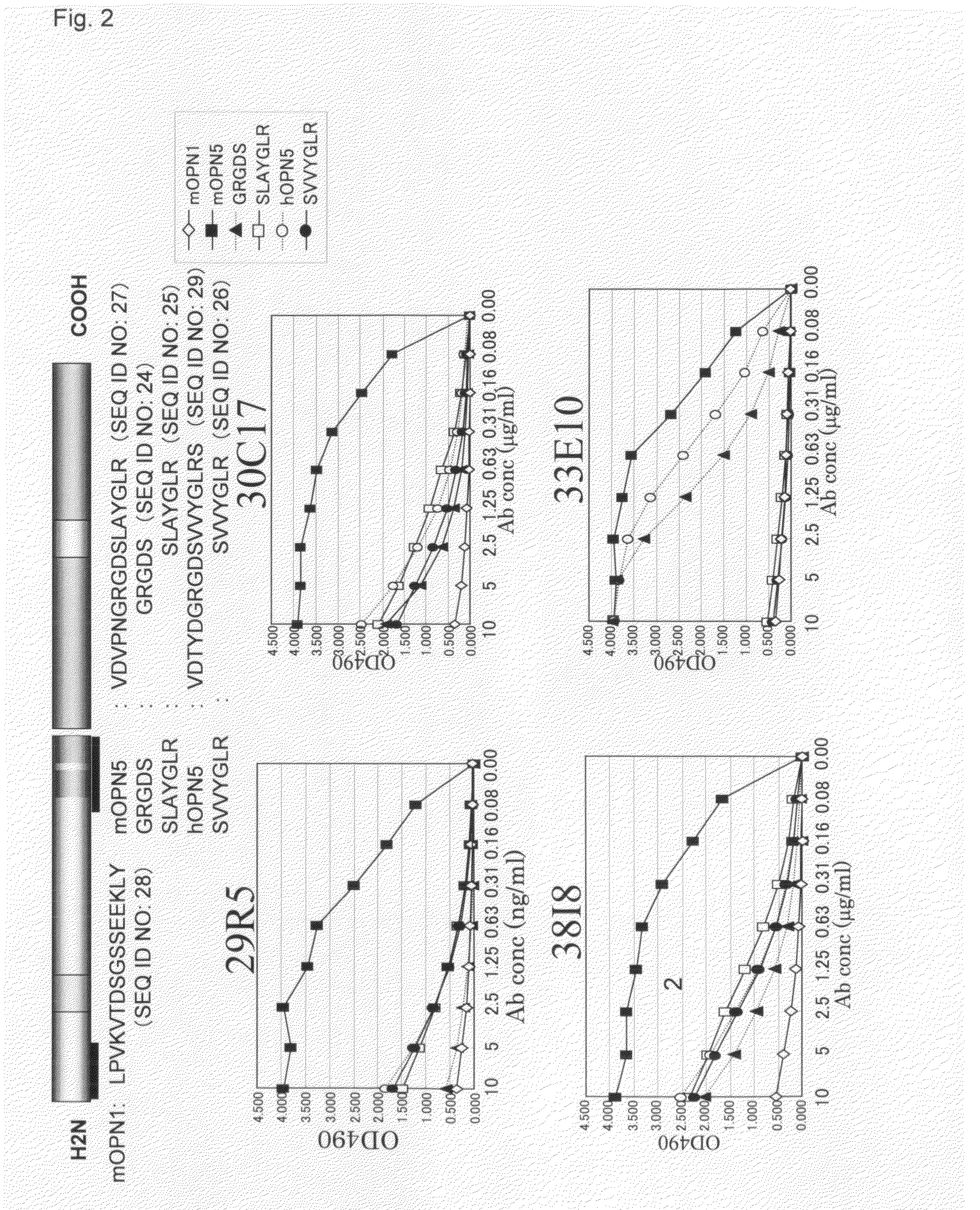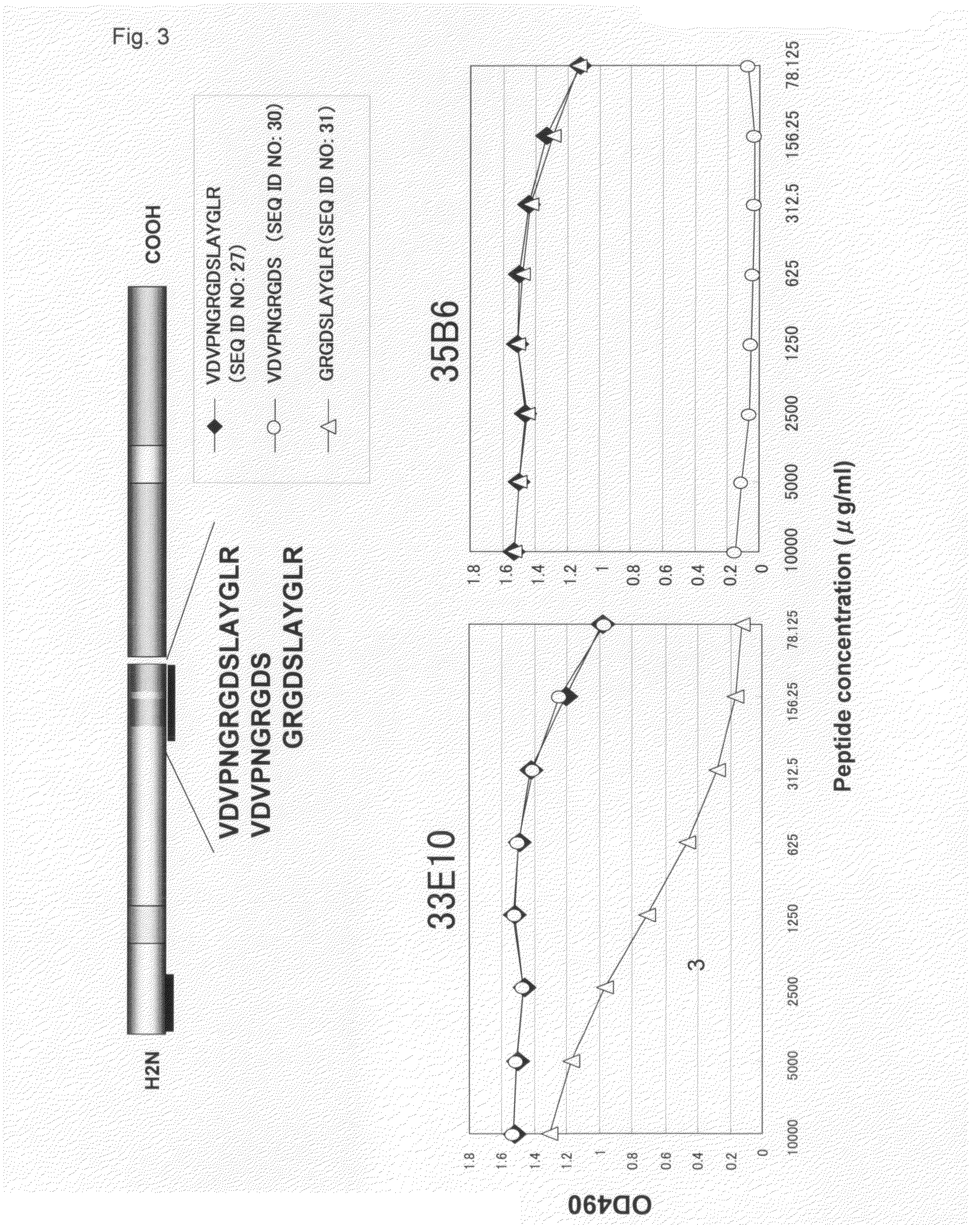Antibody against rgd in amino acid sequence of extracellular matrix protein and production method and use of the same
an amino acid sequence and protein technology, applied in the field of antibody to rgd in the amino acid sequence of an extracellular matrix protein, can solve the problems of undesired action in the body and generation of adverse effects, and achieve the effect of inhibiting the binding of extracellular matrix protein
- Summary
- Abstract
- Description
- Claims
- Application Information
AI Technical Summary
Benefits of technology
Problems solved by technology
Method used
Image
Examples
example 1
Method for Preparing Antibody
The sequence CVDVPNGRGDSLAYGLR (SEQ ID NO: 13) including the RGD sequence which is the cell adhesion sequence of extracellular matrix protein and the sequence SLAYGLR (SEQ ID NO: 25) was synthesized to be combined with thyroglobulin (Sigma) via EMCS (Dojin), and a mouse was immunized with this as an immunogen together with adjuvant. After immunization was performed 4 times, splenic cell was collected to be subjected to cell fusion with myeloma cell X63-Ag8-653. After selection using a HAT medium, culture supernatant was screened using the ELISA method in which antigen peptide was immobilized to select hybridomas which produce antibodies recognizing the RGD sequence (8 clones: 4P11, 11M6, 25H15, 29R5, 30C17, 33E10, 35B6, 3818). An antigen peptide column was prepared using thiol sepharose beads (Amasham Bioscience), and antibodies were purified from supernatant of hybridomas.
The obtained hybridoma cells 33E10 and 35B6 were deposited to International Patent...
example 2
Analysis of Epitope
[Peptides Used for Analysis]
mOPN1 (CLPVKTDSGSSEEKLY (SEQ ID NO: 14)), mOPN5 (CVDVPNGRGDSLAYGLR (SEQ ID NO: 13)), CVDVPNGRGDS (SEQ ID NO: 15), CPNGRGD (SEQ ID NO: 16), CGRGDSLAYGLR (SEQ ID NO: 17), CGDSLAYG (SEQ ID NO: 18), CGDSLAYGLR (SEQ ID NO: 19) and CSLAYGLR (SEQ ID NO: 20), which comprise a partial peptide derived from synthesized mouse OPN; hOPN5 (CVDTYDGRGDSVVYGLRS (SEQ ID NO: 21)) and CSVVYGLR (SEQ ID NO: 22), which are partial peptides derived from human OPN; and CGRGDS (SEQ ID NO: 23), which comprises a partial peptide common to a mouse and a human, were combined with BSA (Sigma) via EMCS (Dojin), and used as peptides for ELISA analysis.
Peptides (10 μg / ml) or proteins (5 μg / ml) were left on a 96-well plate at 37° C. for 1 hour to be immobilized. After blocking with 0.1% BSA / PBS / 0.05% NaN3 solution, antibodies were reacted at various concentrations at 37° C. for 1 hour. Next, the plate was reacted with HRP-labeled anti-murine IgG antibody (J...
example 3
Analysis of Amino Acid Sequences of Antibodies
RNAs were extracted from hybridoma cells using RNeasy Mini kit (Qiagen), and cDNAs were prepared using First-strand cDNA synthesis kit (Amasham Bioscience). Heavy chain cDNA of the antibody was extended by PCR using Heavy primer amplification kit (Amasham Bioscience), and it was incorporated into pCRII-TOPO vector (invitrogen), and then the cDNA sequence and the amino acid sequence were determined. The CDR region was determined by ABG: Directory of 3D structures of antibodies (http: / / www.ibt.unam.mx / vir / structure / structures.html) and blast for Ig sequence (http: / / www.ncbi.nlm.nih.gov / igblast).
As a result, the variable regions and CDR regions of heavy chain and light chain are the following amino acid sequences (also shown in FIG. 6 and FIG. 7):
(Heavy chain)[CDRH1]33E10:GFTFTDYYMI(SEQ ID NO: 1)35B6:GYTFTNYWMH(SEQ ID NO: 2)[CDRH2]33E10:WLGFIRNKANGYTTEYSASVKG(SEQ ID NO: 3)35B6:WIGNINPRNGDSNYNEKFRS(SEQ ID NO: 4)[CDRH3]33E10:GAY(SEQ ID NO: 5)...
PUM
| Property | Measurement | Unit |
|---|---|---|
| temperature | aaaaa | aaaaa |
| adhesion | aaaaa | aaaaa |
| cell adhesion | aaaaa | aaaaa |
Abstract
Description
Claims
Application Information
 Login to View More
Login to View More - R&D
- Intellectual Property
- Life Sciences
- Materials
- Tech Scout
- Unparalleled Data Quality
- Higher Quality Content
- 60% Fewer Hallucinations
Browse by: Latest US Patents, China's latest patents, Technical Efficacy Thesaurus, Application Domain, Technology Topic, Popular Technical Reports.
© 2025 PatSnap. All rights reserved.Legal|Privacy policy|Modern Slavery Act Transparency Statement|Sitemap|About US| Contact US: help@patsnap.com



